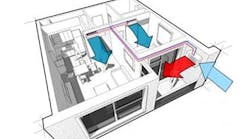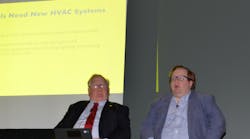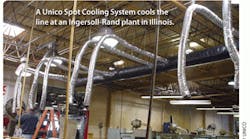A well-equipped HVAC contractor deals in all types of cooling, including the movable kind. Better known as spot cooling, these easy-to-position and versatile units are comfort on wheels, portable air-conditioning systems that can be easily placed where your customers need them. They can be moved from room to room, or be strategically positioned over a long period of time. They provide cooling and dehumidification for hot spots in an office or building, or for areas that tend to overheat and require consistent lower temperatures, such as a computer server room.
While energy costs continue to climb, utility companies are frequently unable to provide all of the electricity that a plant, laboratory, hospital, or office complex may require. When circumstances force a business to control capital expenses, spot cooling provides efficient, low-cost cooling.
Garth Tagge is vice president of sales for Spot Coolers, Norcross, GA, a preferred nationwide distributor of Movin Cool portable cooling products. Spot Coolers deals exclusively in portable air conditioning, units of 1- to 5-ton capacities that can be easily brought into a commercial building.
Thirty years after portable air conditioning was introduced to the HVAC market, Tagge says its achieved full acceptance and awareness as a valuable service.
"As we've watched the market develop, we've seen it become something that's expected by customers. Much like cable television or microwave ovens, portable cooling has become common, a required and essential product and service," Tagge says. Contractors are specifying portable air conditioning more often. They'll often request a unit before the contractor ever makes the suggestion.
The best-outfitted suppliers carry a variety of units for leasing, in different sizes and configurations. This saves the HVAC contractor from buying a standby unit, which may not apply to every cooling need.
"We have five or six types of 5-tonners to rent, and they all have specific purposes," Tagge explains. "An HVAC contractor wouldn't want to buy one type of five-ton unit, because it may not be applicable in every situation. They may need a water cooled unit one week, and an air-cooled unit the next," he says.
"Portable units provide quick and easy installations. They're a great option to offer customers to keep areas cooled during transition periods," adds Eddie Stevenson, marketing manager for MovinCool, Long Beach, CA. "If clients are adding heat loads from something such as server equipment, it might be more cost efficient to supplement the cooling permanently with our unit rather than change the entire system."
On the Spot When Needed
Batchelor & Kimball, Livonia, GA, provides commercial HVAC, plumbing, and fire protection for a wide range of facilities, including hospitals, industrial centers, and data centers.
John O'Neil, assistant vice president, is one of Spot Coolers' happiest customers. He calls for a portable cooling unit based on two contingencies: an emergency cooling need due to a failure of forced air equipment, or to accommodate a temporary shutdown of the forced air system.
"If it's an emergency, Spot Coolers offers 24-hour service, and there's always someone to talk to. That's what we expect, from a customer service standpoint," O'Neil says. "We give them the address, the number of units we need, and tell them we need them as fast as possible. Sometimes they can get them to the site within an hour. We might need them for a computer room, telephone equipment room, or hospital."
Spot cooling at a moment's notice not only brings cool comfort to customers; it also makes the contractor a hero. "Customers take notice of it as an important part of what we do. They call us because they know we can get equipment when they want it," O'Neil says.
Beyond Comfort, to Network Security
Comfort is important. However, in some situations, the enhanced value of timely portable cooling can include preventing the failure of an entire communications network. Ed Smith has been there. He's executive director of mechanical operations for the HVAC service division of Roth Brothers, Inc., Youngstown, OH. Roth Brothers provides Design/Build mechanical work for commercial, retail, office, and industrial customers across the U.S.
"A major air conditioning unit failed at a power plant control room," Smith recalls. "If that control room overheated, the generators would have shut down, killing power to millions of homes. Another prime example is in server rooms or computer rooms. When a crucial piece of air conditioning equipment fails, we mobilize portable equipment in critical spots to keep computers and servers operating. Otherwise, the failure could crash an entire network."
That's why time is of the essence. A fast response when the mercury's climbing means everything.
One of Roth Brothers' major portable cooling suppliers is Topp Portable Air, Aston, PA. Topp offers a complete, line of portable air conditioners, MovinCool spot coolers, and large mobile air conditioners at locations across the U.S.
"They're always there on the spot with a variety of portable air conditioners. With Topp, we're able to bring in the range of cooling our customers need," Smith says.
Ken Morello, director of sales for Topp Portable Air, says contractors appreciate the units' "tactical” benefits.
"Portable air conditioners serve as a tactical solution while a permanent air conditioning system is being repaired or replaced. More and more contractors understand the value of portable air conditioning as a cost-effective viable solution," Morello says. "Installation is quick, easy, and cost-effective, and is complete in a matter of minutes."
Flexible Duct Option
"We see the interest in spot cooling being driven by energy efficiency and savings," says Randy Niederer, director of marketing for Unico, Inc., manufacturers of The Unico System, based in St. Louis, MO. Their spot cooling method — the Unico Spot Cooling System — uses 2.5-in. flexible aluminum ductwork coming off of a main plenum.
"The ductwork retains its positioning, so that you can point the cooling to the appropriate area. Unico is a high velocity system. It moves the air at about 1,600 feet per minute," Niederer explains.
Page 2 of 2
According to Niederer, The Unico System provides what can become a "permanent" cooling solution, however, it can easily be reconfigured as workers move within their stations, or as a production line is modified. "If you have a 2- to 4-ton unit, you can have up to 30 outlets coming off that one unit, which would take up less space than multiple portable units," he says.
Unico supply tubing allows conditioned air to be delivered directly to the immediate area or spot surrounding the factory worker. It's a source of effective relief, without conditioning areas that don’t contain workers.
"If you have a 500,000sq. ft. warehouse that contains a manufacturing line, you spot cool just the area in which the workers are located. Or, it could be used in a restaurant kitchen, or to cool the tee boxes at golf driving range," Niederer says.
"In these applications, it makes more sense just to cool the smaller space. By coming down from the ceiling, it offers versatility. Whereas, with a portable unit, you’re restricted to the specific area you roll it into."
Clearly, there are cooling options for many locations and needs within a work area. Explore the options, stay cool, and make a decision that's best for you and your customers.
Expect the Need and Plan Ahead
Clark Michel, vice president, Atlas Sales & Rentals, Inc., based in Newark, CA, suggests contractors promote "planned emergency cooling" in preparation for what will surely crop up over a long, hot summer. Take the time visit with customers and help them evaluate their situation. What areas will need to be cooled in an emergency? What are the requirements for power, electrical cables, and accessories? Is a backup generator available?
"Work with the customer to develop a written plan that includes a list of the specific areas to be cooled, a full inventory of the needed portable equipment, and emergency contact procedures," Michel says. "Planning ahead is the best way to make sure you'll be able to deliver the right equipment at the right time."
Michel adds that savvy contractors know portable cooling is no longer just an emergency service; it's all in a day's work.
""When an HVAC system must be shut down for refurbishment or replacement — or when a system is down for service or repair and a part is delayed — portable air conditioning can fill the gap and keep your customer cool, in more ways than one,'" he says.
"If your customer has increased heat load by adding equipment, people, or floor space, the addition of portable cooling can be more flexible and more affordable than trying to upgrade the installed HVAC system."










